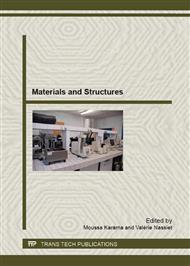[1]
ML. Soni: Finite element analysis of viscoelastically damped sandwich structures. Shock Vib Bull,55(1) (1981), 97–109.
Google Scholar
[2]
F. Abdoun, L. Azrar and E.M. Daya: Damping and forced vibration analyses of viscoelastic shells. International Journal for Computational Methods in Engineering Science and Mechanics, 11(2) (2010), 109–122.
DOI: 10.1080/15502280903563533
Google Scholar
[3]
F. Abdoun, L. Azrar, E.M. Daya and M. Potier-Ferry: Forced vibrations of sandwich viscoelastic beams and plates by an Asymptotic Numerical Method. Computers & Structures, 87(1-2) (2009), 91-100.
DOI: 10.1016/j.compstruc.2008.08.006
Google Scholar
[4]
E.M. Daya and M. Potier-Ferry: A numerical method for nonlinear eigenvalue problem, application to vibrations of viscoelastic structures. Computers &Structures; 79(5) (2001), 533–41
DOI: 10.1016/s0045-7949(00)00151-6
Google Scholar
[5]
B.A. Ma and J.F. He: Finite element analysis of viscoelastically damped sandwich plates. Journal of Sound and Vibration, 52(1992), 107–123.
DOI: 10.1016/0022-460x(92)90068-9
Google Scholar
[6]
D.K. Rao: Frequency and loss factor of sandwich beams under various boundary conditions. Journal of Mechanical Engineering Science, 20(5) (1978), 271–282.
DOI: 10.1243/jmes_jour_1978_020_047_02
Google Scholar
[7]
A. Benjeddou: Advances in hybrid active-passive vibration and noise control via piezoelectric and viscoelastic constrained layer treatments. J. Vib. Control,7(4) 2001,565–602.
DOI: 10.1177/107754630100700406
Google Scholar
[8]
H. Boudaoud, S. Belouettar, E.M. Daya, M. Potier-Ferry: A shell element for active-passive vibration control of composite structures with piezoelectric and viscoelastic layers, Mechanics of Advanced Materials and Structures, 15(2008), 208–219.
DOI: 10.1080/15376490801907699
Google Scholar
[9]
A. Benjeddou, M. A. Trindade and R. Ohayon: A unified beam finite element model for extension and shear piezoelectric actuation mechanisms. J. Intell. Mater. Syst. Struct. 8 1012 (1997).
DOI: 10.1177/1045389x9700801202
Google Scholar
[10]
S.S. Rao and M. Sunar: Piezoelectricity and its use in disturbance sensing and control of flexible structures: A survey. Appl. Mech. Rev. 47 (4) (1994), 113–123.
DOI: 10.1115/1.3111074
Google Scholar
[11]
M. Sunar, S.S. Rao: Recent advances in sensing and control of flexible structures via piezoelectric materials technology. Appl. Mech. Rev. 52 (1) (1999), 1–16.
DOI: 10.1115/1.3098923
Google Scholar


